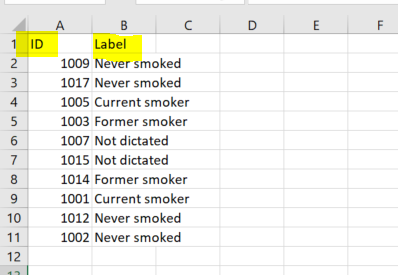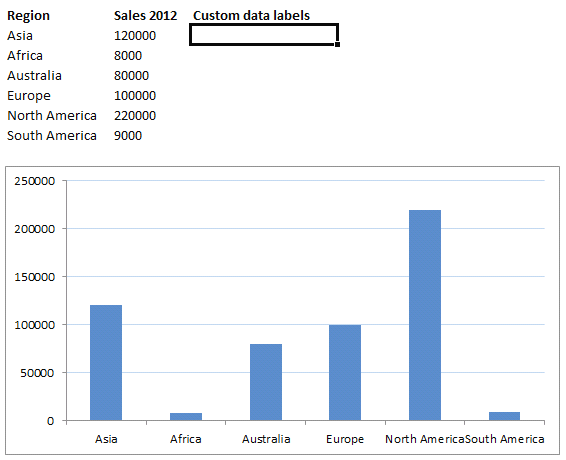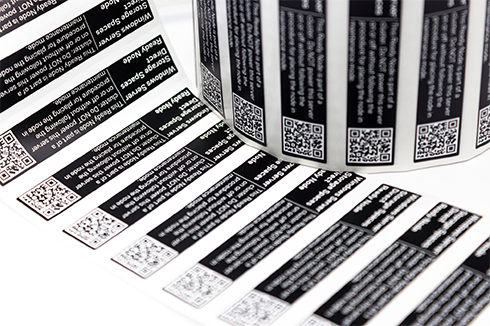38 data labels in r
How to Add Labels Over Each Bar in Barplot in R? - Data ... Let us use gapminder data to make barplots. We will download the data directly from github page. ... Barplot with labels on each bar with R We can easily customize the text labels on the barplot. For example, we can move the labels on y-axis to contain inside the bars using nudge_y argument. We can also specify the color of the labels on ... Label Encoding in R Using a Label Encoder in R To encode our cities, turn them into numbers, we will use the LabelEncoder class from the superml package. We first create an instance of the class using the new method. Then, we use the fit_transform method to encode our variables. library(superml)
R - Data Types - Tutorialspoint In R programming, the very basic data types are the R-objects called vectors which hold elements of different classes as shown above. Please note in R the number of classes is not confined to only the above six types. For example, we can use many atomic vectors and create an array whose class will become array.

Data labels in r
Modify axis, legend, and plot labels using ggplot2 in R ... 21.06.2021 · Adding axis labels and main title in the plot. By default, R will use the variables provided in the Data Frame as the labels of the axis. We can modify them and change their appearance easily. The functions which are used to change axis labels are : xlab( ) : For the horizontal axis. ylab( ) : For the vertical axis. FACTOR in R [CREATE, CHANGE LABELS and CONVERT data] 22.03.2020 · The factor function. The factor function allows you to create factors in R. In the following block we show the arguments of the function with a summarized description. factor(x = character(), # Input vector data levels, # Input of unique x values (optional) labels = levels, # Output labels for the levels (optional) exclude = NA, # Values to be excluded from levels … Label Encoding in R programming - All you need to know ... With Label Encoder, we can format the labelled data into a numeric format. That is, it converts the labelled data of the categorical groups into a numeric format. Let us consider a data variable from a data set with the below labels-. Poll = ['Yes', 'No'] Now, we can here use Label Encoder that would in turn convert the above labels ...
Data labels in r. Bar Charts in R | A Guide on How to Create Simple Bar ... The Basic syntax to create a Bar chart in R is shown below. barplot (H, xlab, ylab, main, names.arg, col) Description of the Parameters are: H denotes height (vector or matrix). If H is a vector, the values determine the heights of the bars. If it is a matrix with option false corresponds to sub bars, and true denotes to create a horizontal bar. Label BoxPlot in R - Delft Stack We can also label the graph properly using the right parameters. The xlab parameter labels the x-axis and ylab parameter labels the y axis. The main parameter sets the title of the graph. We can label the different groups present in the plot using the names parameter. The following code and graph will show the use of all these parameters. labels function - RDocumentation labels (data) returns a named vector of variable labels, where the names match the variable names and the values represent the labels. Details All labels are stored as attributes of the columns of the data frame, i.e., each variable has (up to) one attribute which contains the variable lable. Draw Scatterplot with Labels in R (3 Examples) | Base R ... Example 1: Add Labels to Base R Scatterplot. This Example illustrates how to draw labels to a plot created with the basic installation of the R programming language. For this, we have to use the plot() and text() functions as shown below. Note that we have to increase the xlim of our plot to give enough space for the labels:
PIPING HOT DATA: Leveraging labelled data in R With R's haven, labelled, and sjlabelled packages, you can leverage the inherent data labelling structure in these data sets to work interactively with variable and value labels, making it easier to navigate data while also allowing the user to convert metadata to data. This post discusses general characteristics of labelled data and ... 5.11 Labeling Points in a Scatter Plot | R Graphics ... To automatically add the labels from your data (Figure 5.30, right), use geom_text() and map a column that is a factor or character vector to the label aesthetic. In this case, we'll use Name, and we'll make the font slightly smaller to reduce crowding.The default value for size is 5, which doesn't correspond directly to a point size: 3.9 Adding Labels to a Bar Graph | R Graphics Cookbook ... Another common scenario is to add labels for a bar graph of counts instead of values. To do this, use geom_bar (), which adds bars whose height is proportional to the number of rows, and then use geom_text () with counts: cran.r-project.org › doc › manualsR Data Import/Export a hundredfold since. For specialist data formats it is worth searching to see if a suitable package already exists. 1.1 Imports The easiest form of data to import into R is a simple text file, and this will often be acceptable for problems of small or medium scale. The primary function to import from a text file isscan, and
Map with Data Labels in R Open the R console and use the following code to install maps. install.packages ('maps') Install Maps Package Repeat this process for installing ggplot2. install.packages ('ggplot2') After installing the R packages we are ready to work in PowerBI Desktop. First, we need to load our sample data. Open up PowerBI Desktop and start a blank query. Getting variable labels in R, from SPSS | R-bloggers Voila, 5 lines of code to get my SPSS data and variable labels into R. Related. Share Tweet. To leave a comment for the author, please follow the link and comment on their blog: R in the Antipodes. R-bloggers.com offers daily e-mail updates about R news and tutorials about learning R and many other topics. Draw Scatterplot with Labels in R (3 Examples) | Base R ... Have a look at the previous output of the RStudio console. It shows that our exemplifying data consists of five rows and three columns. The variables x and y contain numeric values for an xyplot and the variable label contains the names for the points of the plot. Example 1: Add Labels to Base R Scatterplot Exploring Data and Descriptive Statistics (using R) to.data.frame = TRUE, use.value.labels=TRUE, use.missings = to.data.frame) # Where: # # ‘to.data.frame’ return a data frame. # # ‘use.value.labels’ Convert variables with value labels into R factors with those levels. # # ‘use.missings’ logical: should information on user-defined missing values be used to set the corresponding ...
labels.data.frame: Extract labels from and set labels for ... One can set or extract labels from data.frame objects. If no labels are specified labels (data) returns the column names of the data frame. Using abbreviate = TRUE, all labels are abbreviated to (at least) 4 characters such that they are unique. Other minimal lengths can specified by setting minlength (see examples below).
How to Label Points on a Scatterplot in R (With Examples) Example 1: Label Scatterplot Points in Base R. To add labels to scatterplot points in base R you can use the text () function, which uses the following syntax: text (x, y, labels, …) x: The x-coordinate of the labels. y: The y-coordinate of the labels. labels: The text to use for the labels. The following code shows how to label a single ...
Data Visualization With R - Title and Axis Labels ... This is the second post of the series Data Visualization With R. In the previous post, we explored the plot () function and observed the different types of plots it generated. In this post, we will learn how to add: Title. Subtitle. Axis Labels. to a plot and how to modify: Axis range. In the previous post, we created plots which did not have ...
Chapter 4 Labels | Data Visualization with ggplot2 4.6 Axis Range. In certain scenarios, you may want to modify the range of the axis. In ggplot2, we can achieve this using: xlim() ylim() expand_limits() xlim() and ylim() take a numeric vector of length 2 as input expand_limits() takes two numeric vectors (each of length 2), one for each axis in all of the above functions, the first element represents the lower limit and the second element ...
How to create ggplot labels in R | InfoWorld Sometimes you may want to label only a few points of special interest and not all of your data. You can do so by specifying a subset of data in the data argument of geom_label_repel (): ma_graph2 +...
Change Table Names & Labels in R (2 Examples) | How to ... Table Names & Labels in R (2 Examples) In this R programming tutorial you'll learn how to change the names and labels of a table object. Table of contents: 1) Example Data. 2) Example 1: Change Column Names of Table Object. 3) Example 2: Change Row Names of Table Object. 4) Video & Further Resources.
r - How to Add Data Labels to ggplot - Stack Overflow 03.04.2017 · Attempting to add data labels to a barplot, using ggplot is giving me the following error: Error: geom_text requires the following missing aesthetics: x My …
How to Add Labels Directly in ggplot2 in R - GeeksforGeeks Labels are textual entities that have information about the data point they are attached to which helps in determining the context of those data points. In this article, we will discuss how to directly add labels to ggplot2 in R programming language. To put labels directly in the ggplot2 plot we add data related to the label in the data frame.
dataframe - R: Assign variable labels of data frame ... 08.12.2014 · I also have a named vector with the variable labels for this data frame: var.labels <- c(age = "Age in Years", sex = "Sex of the participant") I want to assign the variable labels in var.labels to the columns in the data frame data using the function label from the Hmisc package. I can do them one by one like this and check the result afterwards:
R Data Import/Export The easiest form of data to import into R is a simple text file, and this will often be acceptable for problems of small or medium scale. The primary function to import from a text file isscan, and this underlies most of the more convenient functions discussed in Chapter 2 [Spreadsheet-like data], page 6. However, all statistical consultants are familiar with being presented by a client with a ...
Plot ranges of data in R - Burns Statistics 21.02.2013 · How to control the limits of data values in R plots. R has multiple graphics engines. Here we will talk about the base graphics and the ggplot2 package. We’ll create a bit of data to use in the examples: one2ten <- 1:10 ggplot2 demands that you have a data frame: ggdat <- data.frame(first=one2ten, second=one2ten) Seriously […]
Quick-R: Value Labels To understand value labels in R, you need to understand the data structure factor. You can use the factor function to create your own value labels. # variable v1 is coded 1, 2 or 3 # we want to attach value labels 1=red, 2=blue, 3=green mydata$v1 <- factor (mydata$v1, levels = c (1,2,3), labels = c ("red", "blue", "green"))
R Boxplot labels | How to Create Random data? | Analyzing ... Conclusion – R Boxplot labels. The data grouping is made easy with the help of boxplots. Box plot supports multiple variables as well as various optimizations. We can also vary the scales according to data. Boxplots can be used to compare various data variables or sets. The usability of the boxplot is easy and convenient. We need consistent ...
Working with Labelled Data - cran.r-project.org Restore labels from subsetted data. The base subset() function drops label attributes (or vector attributes in general) when subsetting data. In the sjlabelled-package, there are handy functions to deal with this problem: copy_labels() and remove_labels(). copy_labels() adds back labels to a subsetted data frame based on the original data frame. And remove_labels() removes all label attributes.
Variable and value labels support in base R and other packages The usual way to connect numeric data to labels in R is factor variables. However, factors miss important features which the value labels provide. Factors only allow for integers to be mapped to a text label, these integers have to be a count starting at 1 and every value need to be labelled.
set_labels function - RDocumentation This function adds labels as attribute (named "labels" ) to a variable or vector x, resp. to a set of variables in a data frame or a list-object. A use-case is, for instance, the sjPlot-package, which supports labelled data and automatically assigns labels to axes or legends in plots or to be used in tables. Usage
Adding Labels to Points in a Scatter Plot in R | R-bloggers A data set containing such labels is LifeCycleSavings, a built-in data set in R. Each row contains economic or demographic data for a particular country. In this case, the country is a unique categorical label for each datum.
How to Assign Variable Labels in R - Scripts & Statistics Defining variable labels is a useful way to describe and document datasets. Unlike SPSS, which makes it very easy to define variable labels using the data editor, base R doesn't provide any function to define variable labels (as far as I know). However, Daniel Luedecke's R package sjlablled fills this gap. Let's give an example.















Post a Comment for "38 data labels in r"